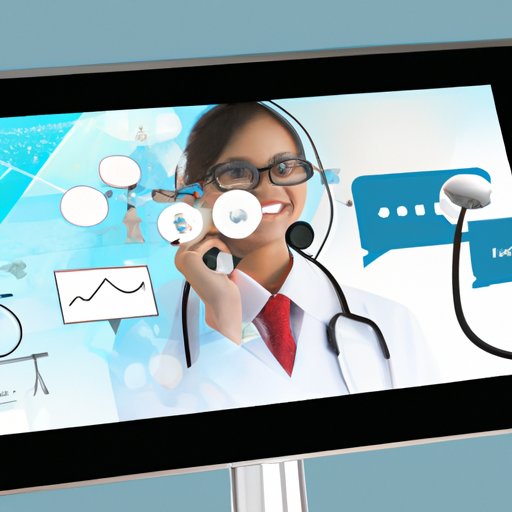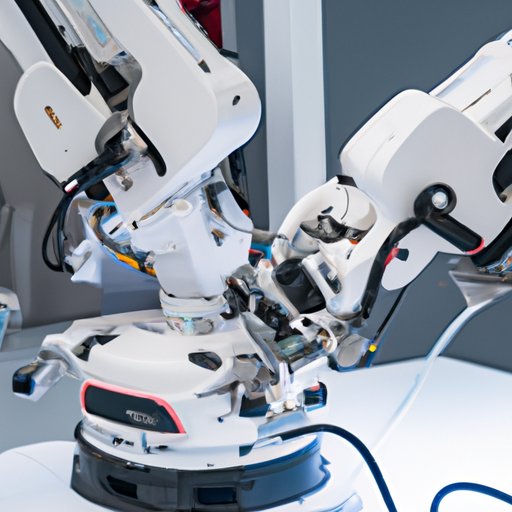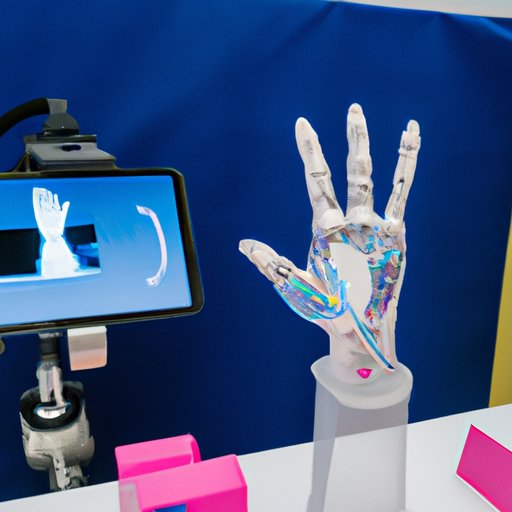Introduction
In recent decades, technology has transformed the way we live, work and play. In the medical field, technology has been at the forefront of many innovations that have improved diagnostic accuracy and treatment efficacy. From advances in medical imaging to the use of artificial intelligence (AI), telemedicine, robots, wearable health monitoring devices and 3D printing, technology has had a profound impact on the field of medicine.

Exploring How Technology Has Improved Diagnostic Accuracy and Treatment Efficacy
Advances in medical imaging have played an important role in improving diagnostic accuracy and treatment efficacy. Medical imaging technologies such as X-ray, ultrasound, computed tomography (CT) scans, magnetic resonance imaging (MRI) and positron emission tomography (PET) scans allow doctors to see inside the body and diagnose diseases or conditions accurately. According to the American College of Radiology, “Medical imaging is a powerful tool used to diagnose and treat millions of patients every day, providing physicians with detailed information to identify disease, plan treatments and assess outcomes.”
In addition to medical imaging, advances in laboratory testing accuracy have also helped improve diagnosis and treatment. Laboratory tests such as blood tests, urine tests and tissue samples can be used to detect diseases or conditions and provide insight into a patient’s overall health. By using more accurate laboratory tests, doctors can make more informed decisions about a patient’s diagnosis and treatment.
Precision medicine is another area where technology has made significant strides. Precision medicine uses genetic information, lifestyle data and environmental factors to develop personalized treatments for patients. This approach has the potential to revolutionize healthcare by providing more effective treatments based on individual needs. According to Dr. Francis Collins, director of the National Institutes of Health, “Precision medicine offers the hope of therapies that are tailored to individual patients and their unique circumstances.”
Examining the Impact of Artificial Intelligence (AI) on Medical Advancements
AI-driven healthcare applications have become increasingly popular in recent years. AI-based systems can be used to analyze large amounts of medical data to detect patterns and anomalies that may otherwise go unnoticed. AI can also be used to automate mundane tasks, freeing up time for healthcare professionals to focus on more complex tasks. According to a study published in Scientific Reports, “AI can help reduce the burden of manual labor for clinicians and other healthcare professionals, enabling them to focus on more complex tasks.”
AI-based systems can also be used for medical diagnosis and treatment. AI-based systems can analyze a patient’s medical history, symptoms and other data to make more accurate diagnoses. Additionally, AI-based systems can be used to develop personalized treatments for patients based on their individual needs. While there are numerous potential benefits of using AI in healthcare, there are also some challenges, such as privacy concerns and bias in the data used to train AI-based systems.

Analyzing the Growth of Telemedicine and Its Implications for Healthcare
Telemedicine has grown in popularity in recent years as a way to provide medical care remotely. Telemedicine allows doctors to consult with patients via video conferencing or other digital communication methods. This provides a convenient way for patients to receive medical care without having to leave their homes. According to a study published in the Journal of Medical Internet Research, “Telemedicine can potentially improve access to care, increase convenience, reduce costs, and improve quality of care for patients.”
Telemedicine also has the potential to improve healthcare outcomes by allowing doctors to monitor a patient’s progress over time. By tracking a patient’s vital signs and other health metrics, doctors can more easily identify any changes in a patient’s condition and take appropriate action. Additionally, telemedicine can help reduce the strain on healthcare systems by allowing doctors to see more patients in a shorter amount of time.
While telemedicine has numerous potential benefits, there are also some challenges. For example, telemedicine requires reliable internet access, which may not be available in some areas. Additionally, telemedicine may not be suitable for certain types of medical care, such as physical examinations or surgeries.

Investigating the Use of Robots in Surgery and Other Medical Procedures
Robotic surgery has become increasingly popular in recent years as a way to perform minimally invasive surgeries with greater precision and accuracy. Robotic surgery involves the use of robotic arms to perform surgical procedures. These robotic arms are controlled by a surgeon who is able to see a magnified, 3D image of the operating site. According to a study published in the New England Journal of Medicine, “Robotic surgery offers several advantages over traditional open surgery, including improved visualization, precise instrument movement, and flexibility of operation.”
Robotic surgery can also help reduce the risk of infection and minimize scarring and recovery time. Additionally, robotic surgery can be used for a variety of medical procedures, including hysterectomies, prostatectomies and other operations. While robotic surgery has numerous potential benefits, there are also some challenges, such as the cost of the equipment and the need for specialized training.
Investigating the Role of Wearable Health Monitoring Devices
Wearable health monitoring devices have become increasingly popular in recent years as a way to track a person’s health and fitness. These devices can measure a person’s heart rate, blood pressure, activity level and other metrics. Additionally, some devices can provide real-time feedback on a person’s health and alert them when something is wrong. According to a study published in the Journal of Medical Internet Research, “Wearable health monitoring devices can help people better understand their health and make informed decisions about their wellbeing.”
Wearable health monitoring devices can also be used to monitor patients with chronic conditions. By tracking a patient’s vital signs and other health metrics, doctors can more easily identify any changes in a patient’s condition and take appropriate action. Additionally, wearables can provide valuable insights into a patient’s lifestyle and behavior that can be used to develop personalized treatments.
While wearable health monitoring devices have numerous potential benefits, there are also some challenges. For example, the accuracy of these devices can vary depending on the device and the user. Additionally, there are privacy concerns associated with collecting and storing personal health data.
Examining the Potential of 3D Printing in Medicine
3D printing has become increasingly popular in recent years as a way to create custom medical devices and implants. 3D printing can be used to create prosthetics, implants, braces and other medical devices quickly and cheaply. Additionally, 3D printing can be used to create models of organs and tissues to help surgeons plan complex operations. According to a study published in the International Journal of Medical Robotics and Computer Assisted Surgery, “3D printing is a promising technology that can be used to create customized medical devices and implants that are tailored to the patient’s specific anatomy.”
3D printing can also be used to create drugs and medications. This process, known as pharmaceutical 3D printing, can be used to create personalized medications with specific dosages and delivery methods. Additionally, 3D printing can be used to create drug delivery systems such as patches, inhalers and pills. While 3D printing has numerous potential benefits, there are also some challenges, such as the need for specialized expertise and the cost of the equipment.
Conclusion
In conclusion, technology has revolutionized medicine in many ways. From advances in medical imaging and laboratory testing to the growth of telemedicine, robotics, wearables and 3D printing, technology has had a profound impact on the field of medicine. While each technology has its own potential benefits and challenges, it is clear that technology will continue to play a key role in transforming healthcare for the better.
(Note: Is this article not meeting your expectations? Do you have knowledge or insights to share? Unlock new opportunities and expand your reach by joining our authors team. Click Registration to join us and share your expertise with our readers.)
